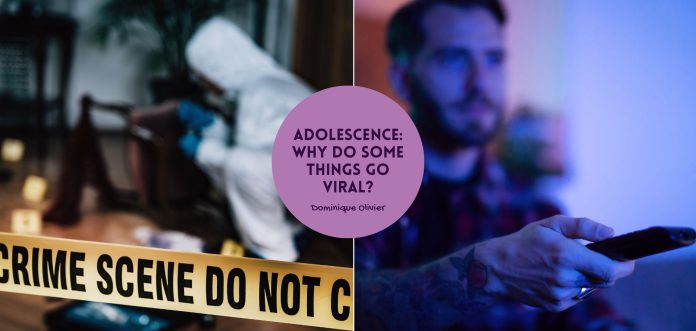There’s a temptation to treat virality like a shot in the dark. But virality isn’t an accident – it’s chemistry. And when it works, it works for a reason: a potent mix of psychology, social contagion, and cultural timing.
Take Adolescence, for example. On paper, it’s a gritty British crime drama about a 13-year-old boy accused of murder. Not exactly easy Friday-night viewing. But since its release on Netflix in mid-March, the series has exploded, clocking nearly 97 million views in three weeks, breaking into Netflix’s all-time top 10, and earning a rare 99% approval rating on Rotten Tomatoes. Critics have praised everything from its haunting cinematography to the rawness of its performances. As for the viewers, well, they just can’t seem to stop talking (or posting on social media) about it.
Not everyone is destined
Defending Jacob is a psychological crime drama miniseries from Apple TV+, based on the 2012 novel by William Landay. It follows Andy Barber (played by Chris Evans – yes, Captain America himself), an assistant district attorney whose life falls apart when his 14-year-old son, Jacob, is accused of murdering a classmate. As the investigation unfolds, the Barbers are forced to confront their darkest fears, hidden family secrets, and the possibility that their child might be capable of terrible things. It’s a slow-burn drama that explores guilt, loyalty, and how far a parent will go to protect their child, even when the truth gets murky.
Now doesn’t that just sound eerily similar to the plotline of Adolescence?
Both series delve into the harrowing narrative of a teenager accused of murder, unraveling the profound impact on their families and communities. Yet, their journeys in the streaming landscape have been markedly different. Defending Jacob, which premiered on Apple TV+ in April 2020, received moderate attention. While it featured prominent actors like Chris Evans and Michelle Dockery and was based on a bestselling novel, it didn’t achieve the same viral momentum. Specific viewership data is scarce, but it didn’t make a significant impact on Apple’s platform or the broader cultural conversation. Fact: I had never heard of this series until I started researching this article.
Two accused teenage boys, two stabbed classmates, two sets of parents trying to figure out where they went wrong. So why did one of these series go viral, while its twin faded into near-obscurity? Let’s dig into the science of virality and how Adolescence managed to hit every nerve just right.
Crank up the emotion
Let’s start with the basics: if you want something to go big, it has to hit people in their feelings. Viral content isn’t just about timing or hashtags; it’s about raw, real, gut-punching emotion. Adolescence understood this concept so well that they practically weaponised it.
The show opens with scenes of 13-year-old Jamie being arrested in his home. We get our first look at him as police officers kick in his bedroom door to the sound of his family members shouting downstairs: he is just a dark-haired little boy with scared eyes. When an officer orders him out of bed, he hesitates but then complies. As he gets up, we see that he has wet his pants.
As a parent, this is the kind of premise that punches your protective instincts square in the sternum. You’re not watching to be entertained. You’re watching because you have to know how this happened. Some combination of dread, fear, anger, and heartbreak has wrapped itself around your nervous system and refuses to let go.
That’s where the science kicks in. According to research from the University of Pennsylvania, content that triggers high-arousal emotions – things like awe, anger, excitement, or horror – gets shared and consumed far more often than things that make us feel calm, sad, or mildly pleased. Why? Because those high-arousal feelings energise us. They make us want to do something. Hit play on the next episode. Message a friend. Post a half-formed opinion in all caps on your social media platform of choice. Tell someone – anyone – that they need to watch this show right now.
People don’t pass things along because they’re educational or beautifully made (although Adolescence is both of things as well). They do it because those things move them. And if those feelings come with a side of adrenaline, even better. That’s why Adolescence didn’t settle for sadness. It went for the throat with a mix of outrage, empathy, and suspense.
Do it for the social currency
Another powerful reason things catch fire is social currency. People share stuff that makes them look good. It sounds shallow, but it’s actually a very human response when you consider that sharing content is a form of self-expression. We post articles to seem informed. We send memes to look funny. We link trailers or TikToks or weird documentaries to say: look at this. I found it first.
Adolescence isn’t exactly the kind of thing you share to make people laugh or fall in love with a character. It’s not a comfort-watch; as we’ve already established, it’s more of a gut-wrench. So why did everyone want everyone else to know that they were watching it?
Social currency isn’t always about being funny or light – it’s about being tuned in. Sharing Adolescence says: I can handle this. I watch the heavy stuff. I engage with the tough questions. I’m not just scrolling, I’m paying attention. The show is dark, unsettling, and emotionally demanding, and that’s part of the reason why it spread. Saying “I just watched the first episode of Adolescence” became shorthand for being thoughtful, serious, emotionally literate; the kind of person who doesn’t look away when things get hard.
That’s the magic of social currency. It doesn’t always have to be fun. It just has to say something about you.
Relatability meets practical value
Virality hinges on relatability, or the feeling that something hits close to home. For many parents, Adolescence feels like a warning.
What the show does so well is hold up a magnifying glass to that terrifying truth all parents know deep down: you can do everything right, and still lose your child to a system that doesn’t care. You see Jamie and you don’t see a stranger; you see your own kid. Or the kid your child goes to school with. Or the version of your child you’ve been praying you’ll never meet.
That’s why it spreads. Parents watch Adolescence and immediately feel the need to tell someone, because it feels urgent. It becomes less about streaming a series and more about starting a conversation about gender, social media, broken systems, and the impossible job of raising kids in a world that’s always online.
Let’s not forget one of the sneakiest forces behind viral success: practical value. When parents share Adolescence, they’re not just saying” “watch this.” They’re saying: know this. Understand what your kids might face. Learn how easy it is for the system to get its claws into a child who looks or lives a certain way. The show becomes a kind of cautionary tale – equal parts documentary and wake-up call – and sharing it feels like passing on a warning that could matter.
All about the platform
The final piece of the virality puzzle is distribution, and that’s all about nailing the timing and the platform. You can create the most emotionally gripping, gut-punch of a story, but if it doesn’t reach the right people at the right time, it won’t take off.
Take Defending Jacob, for example. When it dropped in 2020, it had a lot going for it: a high-profile cast, a darkly compelling storyline, strong production value. But the cultural moment wasn’t quite right. We weren’t having the same urgent, heated conversations about boys, masculinity, and internet influence that dominate the discourse now. Andrew Tate hadn’t exploded across TikTok yet. The concept of “red-pilled” teens wasn’t mainstream. Defending Jacob was good, but it didn’t hit a nerve because that nerve hadn’t been exposed yet.
Adolescence, on the other hand, landed like a meteor. It arrived when people were primed to pay attention, when the world was already worried about how boys are being shaped by digital culture, online misogyny, and the justice system’s response to youth crime. That context matters. Releasing a show like this now doesn’t just feel relevant; it feels necessary.
And then there’s the power of the platform. Netflix’s algorithm didn’t just bury Adolescence somewhere between a cooking docuseries and a nostalgic sitcom rerun. It actively pushed it to the right people: those who binge dark, character-driven dramas and true crime. It found the audience who would care immediately, and that matters more than any trailer ever could. This is the power of streaming and the incredible data that Netflix has on its subscriber behaviour.
The result is that Adolescence didn’t just find an audience, it activated one. Ninety-six million people watched it in three weeks. Not just because it was good (which it is), or because it was a continuous shot (incredible to behold), but because it was everywhere they already were, talking about something they already cared about.
Right content. Right time. Right feed. That’s the viral trifecta. And yes, if you haven’t done so already, you should totally watch Adolescence.
About the author: Dominique Olivier

Dominique Olivier is the founder of human.writer, where she uses her love of storytelling and ideation to help brands solve problems.
She is a weekly columnist in Ghost Mail and collaborates with The Finance Ghost on Ghost Mail Weekender, a Sunday publication designed to help you be more interesting. She now also writes a regular column for Daily Maverick.
Dominique can be reached on LinkedIn here.




